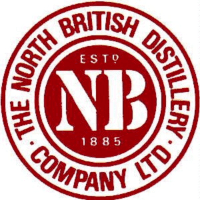Type Private Website NorthBritish.co.uk Number of employees 1,500 Area served Scotland | Products Pure grain alcohol Headquarters Edinburgh, United Kingdom Founded 1885 Parent organization Lothian Distillers Ltd. | |
 | ||
Industry Distillery, Scotch whisky Founder Andrew Usher, William Sanderson, John M. Crabbie Number of locations Gorgie, Edinburgh
Addiewell, West Lothian | ||
North british distillery case study
The North British Distillery Company Ltd is a Scottish grain whisky distillery located in south western Gorgie district of Edinburgh. Established by a group of independent distillers in 1885, it is now a joint venture company between Diageo plc and the privately held Edrington Group. It is Edinburgh’s last working distillery, widely known as "NB". Tynecastle Stadium lies immediately to the southeast.
Contents
History
With grain whisky consumption growing in the industrialised and railway connected Victorian era, independent distillers needed access to a high quality and high volume producer of pure grain alcohol.
In 1885, major shareholders Andrew Usher, William Sanderson and John M. Crabbie, with numerous other whisky-blenders as shareholders, had established the North British Distillery Company Limited. The company bought a 10 acres (4.0 ha) pig farm on the western outskirts of Edinburgh, adjacent to the developing suburb of Gorgie and Dalry. The site had a number of distinct advantages:
Production started in 1887, and within a year of opening the distillery was producing 3,600,000 litres (790,000 imp gal; 950,000 US gal) of spirit per year, output at a price of one shilling and three pence per proof gallon. By the start of World War I, production had risen to 9,000,000 litres (2,000,000 imp gal; 2,400,000 US gal) per annum, but came to a halt in 1917 due to a lack of economic supply of grain. Almost converted to acetone production for use in munitions, the site resumed production in 1920. Having reached pre-war production levels by 1925, with prohibition in the United States, followed by the 1930s Great Depression, production fell to an all-time low of 1,200,000 litres (260,000 imp gal; 320,000 US gal) per annum. Production had barely recovered to similar post-World War I levels by the start of World War II, which again saw production suspended. The site was used initially as a grain store, and latterly as a D Day supplies depot.
Just after resumption of production, in 1948 Scotland's first saladin maltings were installed. With rationing ending in the early 1950s, this spurred production to pre-World War I levels again. In the late 1950s the site was expanded to include the adjacent former Edinburgh Corporation Tramways depot, to provide space for new warehouses. In 1967, the Darney quarry at East Woodburn, Northumberland was reopened to allow an extension to the buildings in the original stone, and kept open for two years to allow additional offices and brewing facilities to be added.
In 1970, 30 acres (12 ha) of land were purchased at Addiewell, West Lothian to create six new racked warehouses and a filling store, added to by an additional three racked warehouses in 1975. That same year an additional 30 acres (12 ha) adjacent plot was purchased on the opposite (south) side of the A71 road. At this time, expansion of output was enabled by substantial investment in production facilities enabling 36,400,000 litres (8,000,000 imp gal; 9,600,000 US gal) to be produced in 1979.
The late 1970s/early 1980s downturn brought job losses, as production capacity had been planned on a 10% year-on-year increase. After output fell to 11,400,000 litres (2,500,000 imp gal; 3,000,000 US gal), the economic revival brought consolidation across Scotch whisky production, and resulted in the 1988 closure of the Caledonian, Edinburgh's other grain distillery. Hence by 1991, output had recovered to 41,700,000 litres (9,200,000 imp gal; 11,000,000 US gal).
In 1993, shareholders Robertson & Baxter and International Distillers & Vintners formed joint venture company Lothian Distillers, which bought out all other shareholders for an agreed price of £84 Million. After the completion of the replacement of the exploded No.4 still, an expansion plan allowed the production of a grain-neutral spirt to support IDV's Smirnoff vodka brand, and maximum plant capacity to rise to 61,600,000 litres (13,600,000 imp gal; 16,300,000 US gal). In February 1998, the company produced its 1,500,000,000 l.alc of whisky since its inception in 1885. A commemorative new bourbon barrel was filled to mark the occasion, and took pride of place in No. 1 warehouse at Wheatfield Road.
Rationalisation led to the sale of the maltings and warehouse site on Slateford Road and the Westfield Road warehousing site in 2002 and 2003 respectively. Warehousing in Edinburgh is now restricted to the original No. 1 Warehouse at Wheatfield Road which offers traditional style storage for casks laid down for longer periods of maturation. The vast majority of maturation warehousing is at Addiewell where a further four warehouses have been built since 2002, on the site bought in 1975.
Current
Lothian Distillers, and hence the sites and production, is jointly owned by Diageo plc and the privately held Edrington Group. Increased sales of Scotch whisky to India, China and South America brought about production of 65,000,000 litres (14,000,000 imp gal; 17,000,000 US gal) in 2007, produced for:
To enable this, the company imports maize (3,000 tonnes (3,300 tons) per week from France via the Port of Leith), along with a lesser amount of malted barley. The waste output husks are pelletised into cattle-feed, while the liquefied carbon dioxide is sold via contractor Air Products.
